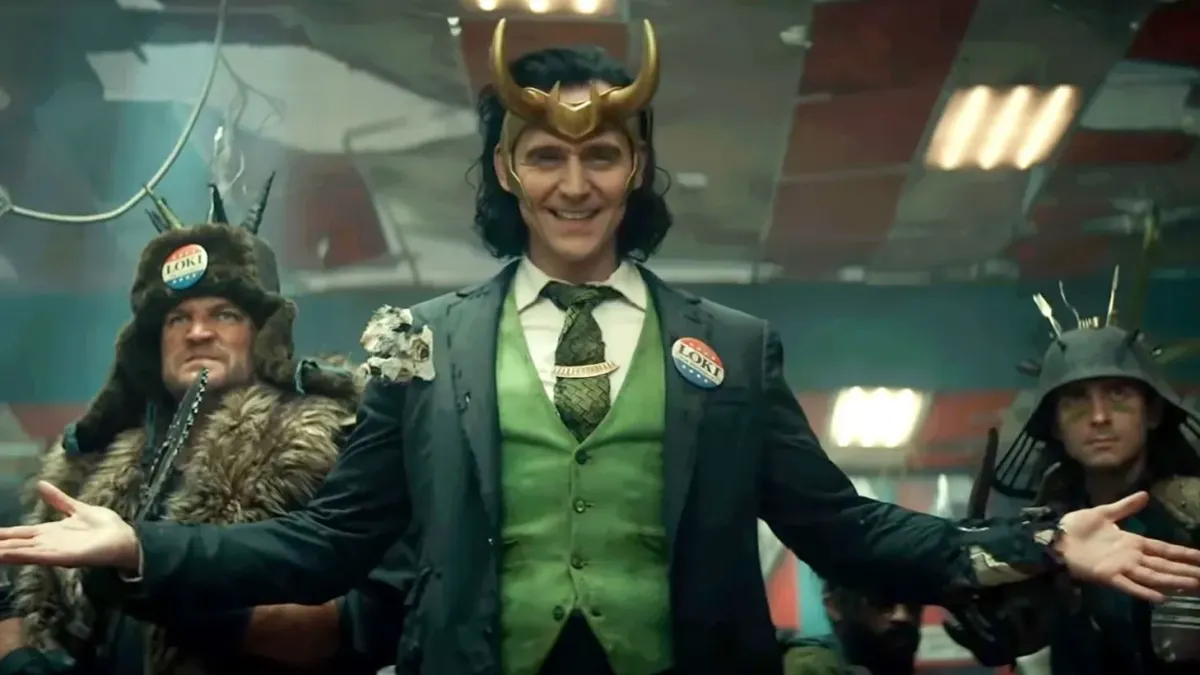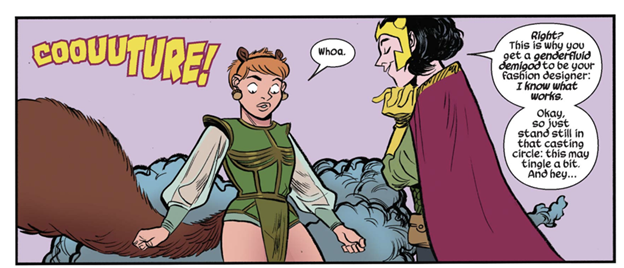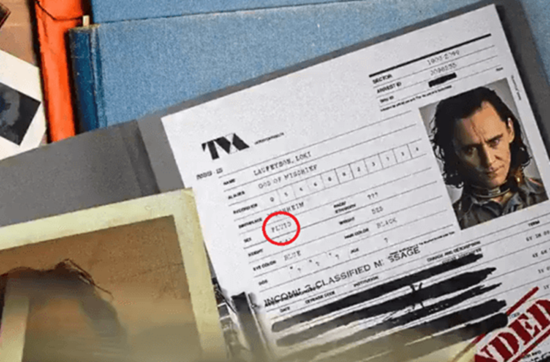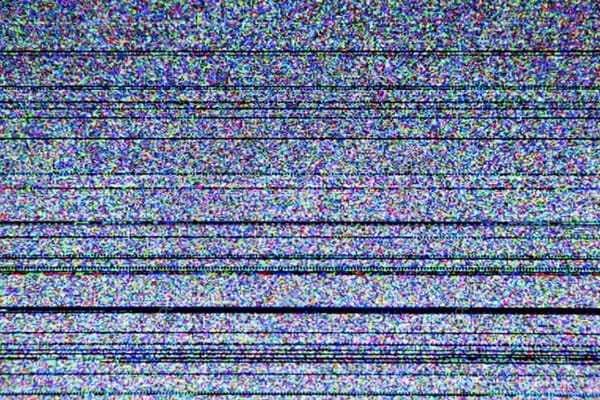Let Loki be Loki, gender-fluidity and all
The Disney+ series takes several tiny steps toward addressing its title character's gender. They're too tiny.

(Welcome to the Wednesday newsletter! Each week, I’m publishing a new pop culture essay from a freelancer. Remember: Your subscription fee helps me pay these freelancers for their efforts! This week: Reyne Martinez on why Disney+'s Loki doesn't do right by the character.)
In June, Loki premiered on Disney+ to an audience that knew the trickster god largely from a decade of movies. Tom Hiddleston’s portrayal of Loki in several films in the Marvel Cinematic Universe won viewers’ hearts, despite the god’s misdeeds.
Fans who got to know Marvel’s characters through the studio’s movies understand who Loki is. They’re a prankster for the ages, the menacing, conniving adopted younger sibling of Thor. (And since we’re talking about Loki’s canonical gender fluidity and exploration of gender throughout various media, we’ll be using they/them pronouns for the god of mischief.)
Loki exists to sow chaos. The character has reminded us as much many, many times. Thor: Ragnarok pushes Loki from a chaotic evil role and into a chaotic neutral role, sure. But always, at the end of the day, the audience understood that Loki would do what was best for Loki.
Until the TV show.
In both mythological and comic form, Loki's gender-fluidity is embraced
Season one of the series turned the trickster god inside out. Loki took part in intense therapy sessions with Mobius (Owen Wilson). Loki also met other Lokis who were different one way or another. The audience got to know all possible facets of the trickster god. Old, Black, reptilian, political – all these Lokis gave us a deeper understanding of who Loki is. Loki is chaotic within all kinds of parameters and capable of anything behind any face. But always, Loki survives.
And yet – only one documented Loki identifies as female.
Norse mythology never shied away from Loki’s transitional identity. These storytellers may have lacked the same language around gender that we have with which to encapsulate how the trickster lived. But every time Loki shifted into a woman or laid down with a man, it was recorded. Loki used their shape-shifting abilities to become both mother and father, according to these myths.
Loki fathered children with Sigyn, the goddess of victory, and a giant named Angrboda. But Loki also once shifted into a mare and coupled with a horse, eventually giving birth to an eight-legged steed named Sleipnir. In Norse society, same-sex relationships were commonplace, but there was backlash about men receiving while engaging in sex. These men went by the derogatory term "mare,” a term that implied one male partner was submissive compared to the other. While this tale paints Loki in an odd light, they emerge as a hero. Loki ultimately gifts Sleipner to Odin, something incredibly honorable. That’s Loki: heroic, queer, and having no qualms about shifting as they see fit.
The comics water Loki down in some respects. (Loki first appeared in Marvel Comics in some version of their current form in 1962.) But the comics preserve Loki’s identity as a gender-fluid god.
In Loki: Agent of Asgard, released in 2014, Loki shifts from their male presenting state into Lady Loki, the goddess of stories. While Loki uses he/him and she/her pronouns, they do not claim to be more of one or the other. Loki is always Loki, “first, last, and always.” In the same run, written by Al Ewing, Odin looks to Loki and says, “my child who is neither my son nor my daughter.” Within the pages of Original Sin (also 2014), Loki reminds Thor that they too are a fair maiden at times. Thor doesn’t bat an eyelash.

The writers and artists behind these comics drive home the fact that Loki is Loki in any body. And they were proud of it. Their pride shines through in Vote Loki, and The Unbeatable Squirrel Girl, where Loki’s fluidity shows.

But Disney+ offers fans crumbs, compared to the comics’ meals. Yes, the series technically nods to Loki’s gender fluidity. But look at how the streaming service decides to showcase its first gender-fluid character on screen.
The Marvel Cinematic Universe dodges several great chances to make Loki's identity more explicit
In the movies, Loki is the black sheep of the royal family, with everything from their dagger play to their magic to their style denoting that fact. But in addition to all of the other ways in which they are a black sheep, Loki’s portrayal of masculinity is quite different from the traditional Asgardian standard. Loki have long dark hair, pale skin, and a lean body in comparison to Thor and the Warriors Three. The cut of Loki’s tunics resembles the style of female-presenting Asgardians. They even incorporate yellow into their Ragnarok wardrobe to honor Frigga, their mothe, who is referenced as a source of Loki’s sorcery.
But for the first time in Disney+’s Loki, viewers got to meet a female Loki, who goes by Sylvie and is played by Sophia Di Martino. Sylvie was born with dark hair, awareness of her parentage, and magic. She wears feminine clothing, a golden horn crown, and uses her daggers with precision. She is everything the Loki we know in the MCU could be but assigned female at birth.
At one point, Loki and Sylvie cheekily discuss their sexual proclivities with the line, “Bit of both.” It’s a nod to the fact that Loki is bisexual, but we’ve never seen these romances on screen. Sure, Loki and the Grandmaster got close in Thor: Ragnarok. They got close enough that Loki could identify the ship where all the Grandmaster’s orgies happen. And in the series, Mobius makes a dig about Loki getting close to royals (of all genders, presumably) to overthrow them and seize power. But do we see any of it? No.
We know that Loki is capable of shapeshifting. In Thor: The Dark World they had fun shifting into Lady Sif, among others. But as for transforming into a feminine version of themselves? Nothing. Instead, we get Sylvie, a singular example of Loki existing as a different gender. Sylvie does not shift into a male-presenting body. Her own sexuality is not expanded upon. Her decision to go by Sylvie can portray the trial of being dead named in some ways. But her journey through gender-fluidity is as shallow as Loki’s.
An underlying theme of self-love permeates the show. So, Loki learning to love who they are through the avatar of another version of themselves? That could be perfect. Loki loving Sylvie as she is, empathizing with her, and assisting her in her liberation? Powerful. Loki learning that same love and directing it at themselves, healing from centuries of trauma and confusion? Incredible.
But did Loki actually achieve any of the above? Not really.
Loki develops romantic feelings for Sylvie and practices self-love in a literal, romantic sense. But there is no self-actualization here. Instead, their dual identities shift into a relationship that is heteronormative at first glance.
And the series’ stabs at LGBTQIA+ representation were even more lackluster. Yes, the project made Loki canonically bisexual, and the line that confirms Loki’s bisexuality send waves of validation and celebration through the fandom. Yet the MCU has done little to actually depict Loki’s bisexuality, and it doesn’t really come up in Loki beyond stray dialogue.

Gender fluidity is even further shunted off to the side. Loki’s marker of “Fluid” on their TVA profile is in small text. And while both Loki and Sylvie are iterations of Loki, they are fixed. We don’t see them shift or transition into each other. The Loki we’ve known since the first Thor movie remains largely the Loki of Loki. But further exploring their identity would provide validation to genderfluid audiences starving for any explicit representation. To see Loki presenting as female one day and male the next would have solidified a simple truth: Loki is Loki, and every version of themselves deserves to be seen as such.
Loki certainly has aims beyond representation. As always, the show is part of the MCU’s master plan, with its main story thrust further introducing the multiverse. In the midst of that, not every interpersonal connection and relationship will have its time to shine.
Yet acknowledging a character’s core identity is one of the best ways to connect to an audience. That’s especially true when you consider that Disney and Marvel’s track-record of giving queer characters nods is abysmal. You might see a brief moment between a homosexual couple in The Rise of Skywalker or Frozen. Director Joe Russo cameoed as a gay man whose partner had disappeared in Avengers: Endgame. These moments get press, but they’re far from enough when it comes to actual queer representation.
And it’s not as though coming up with stories about Loki’s genderfluidity is impossible. If the show’s writers are stuck on this point, they can turn to the comics (especially Loki: Agent of Asgard and Original Sin) or the original Norse mythology.
Yes, Loki, one of the most popular characters in the MCU is confirmed to be a part of the LGBTQIA+ community. The brief moments that confirm Loki’s identity are huge for some fams. But this is still too small a step, one that could easily be swept aside by the vast wave of other stories in the MCU. Loki’s story deserves to stand alone. Let Loki be the gender-fluid bisexual being of their dreams, one who is capable of surviving against all odds.
Episodes is published three times per week and edited by Emily VanDerWerff. Mondays feature her thoughts on assorted topics. Wednesdays offer pop culture thoughts from freelance writers. Fridays are TV recaps written by Emily. The Wednesday and Friday editions are only available to subscribers. Suggest topics for future installments via email or on Twitter. Read more of Emily's work at Vox.



